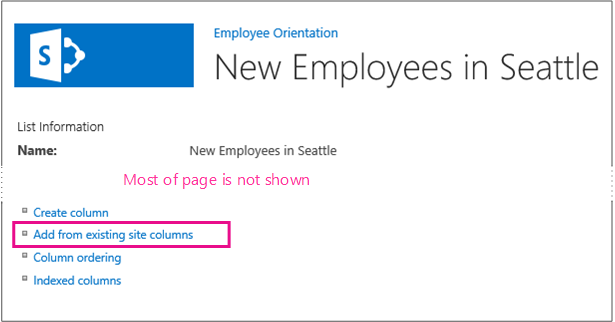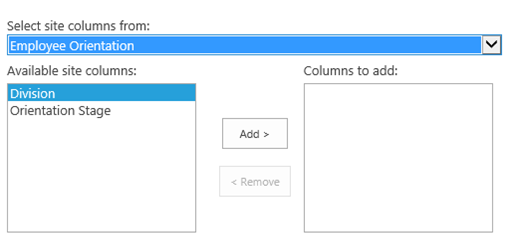Add custom columns to a SharePoint-hosted SharePoint Add-in
Important
The SharePoint Add-In model in SharePoint Online has been deprecated as of November 27th 2023, checkout the full retirement announcement to learn more.
Deprecation means that the feature will not get any new investments, but it's still supported. SharePoint add-in model is retired fully on April 2nd, 2026 and is no longer available after that time. Primary replacement technology for the SharePoint add-in model is SharePoint Framework (SPFx) which continues to be supported also in future.
This is the third in a series of articles about the basics of developing SharePoint-hosted SharePoint Add-ins. You should first be familiar with SharePoint Add-ins and the previous articles in this series, which you can find at Get started creating SharePoint-hosted SharePoint Add-ins | Next steps.
Note
If you have been working through this series about SharePoint-hosted add-ins, you have a Visual Studio solution that you can use to continue with this topic. You can also download the repository at SharePoint_SP-hosted_Add-Ins_Tutorials and open the BeforeColumns.sln file.
In this article, we get back to coding by adding some site columns to the Employee Orientation SharePoint Add-in.
Create custom column types
In Solution Explorer, right-click the project and select Add > New Folder. Name the folder Site Columns.
Right-click the new folder, and select Add > New Item. The Add New Item dialog opens to the Office/SharePoint node.
Select Site Column, give it the name Division, and then select Add.
In the elements.xml file for the new site column, edit the Field element so that it has the attributes and values shown in the following example, except that you should not change the GUID for the ID attribute from the value that Visual Studio generated for it, so be careful if you are using copy-and-paste.
<Field ID="{generated GUID}" Name="Division" Title="Division" DisplayName="Division" Description="The division of the company where the employee works." Group="Employee Orientation" Type="Text" Required ="FALSE"> </Field>Add another Site Column named OrientationStage to the same folder .
In the elements.xml file for the new site column, edit the Field element so that it has the attributes and values shown in the following example, except that you should not change the GUID for the ID attribute from the value that Visual Studio generated for it.
<Field ID="{generated GUID}" Name="OrientationStage" Title="OrientationStage" DisplayName="Orientation Stage" Group="Employee Orientation" Description="The current orientation stage of the employee." Type="Choice" Required ="TRUE"> </Field>Because this is a Choice field, you must specify the possible choices and the order in which they should appear in the drop-down list when a user is making a choice. Because it is a required field, you must specify a default value. Add the following child markup to the Field element, and then save all the files.
<CHOICES> <CHOICE>Not Started</CHOICE> <CHOICE>Tour of building</CHOICE> <CHOICE>HR paperwork</CHOICE> <CHOICE>Corporate network access</CHOICE> <CHOICE>Completed</CHOICE> </CHOICES> <MAPPINGS> <MAPPING Value="1">Not Started</MAPPING> <MAPPING Value="2">Tour of building</MAPPING> <MAPPING Value="3">HR paperwork</MAPPING> <MAPPING Value="4">Corp network access</MAPPING> <MAPPING Value="5">Completed</MAPPING> </MAPPINGS> <Default>Not Started</Default>
Run the add-in and test the columns
Use the F5 key to deploy and run your add-in. Visual Studio makes a temporary installation of the add-in on your test SharePoint site and immediately runs the add-in.
When the add-in's default page opens, select the New Employees in Seattle link to open the custom list instance.
Open the list's Settings page and add the two columns to it with these steps:
Select the callout button, · · · just above the list, and then select Create View.
The View Type page opens, with the breadcrumb structure Settings > View Type near the top. Select the Settings breadcrumb.
Figure 1. Steps to open the list settings page

On the Settings page, open the Add from existing site columns link on the left about halfway down the page.
Figure 2. List settings page

On the Add Columns from Site Columns page, select Employee Orientation on the Select site columns from drop-down list.
Figure 3. Add Columns from Site Columns page

Add the Division and OrientationStage columns to the Columns to add box.
Select OK to return to the Settings page, and then select the New Employees in Seattle breadcrumb near the top of the page.
The new columns are now on the list. Add a new item to the list. On the edit form, the Orientation Stage field will already have the default value Not Started. (The existing items will be blank in this field because they were created before the field was on the list.)
Figure 4. The list with new columns

To end the debugging session, close the browser window or stop debugging in Visual Studio. Each time that you select F5, Visual Studio will retract the previous version of the add-in and install the latest one.
You will work with this add-in and Visual Studio solution in other articles, and it's a good practice to retract the add-in one last time when you are done working with it for a while. Right-click the project in Solution Explorer, and then select Retract.
Next steps
You don't really want your users to have to manually add the custom columns to the list, so in the next article in this series, you'll create a custom content type that includes the custom columns and is automatically associated with the New Employees list template: Add a custom content type to a SharePoint-hosted SharePoint Add-in.